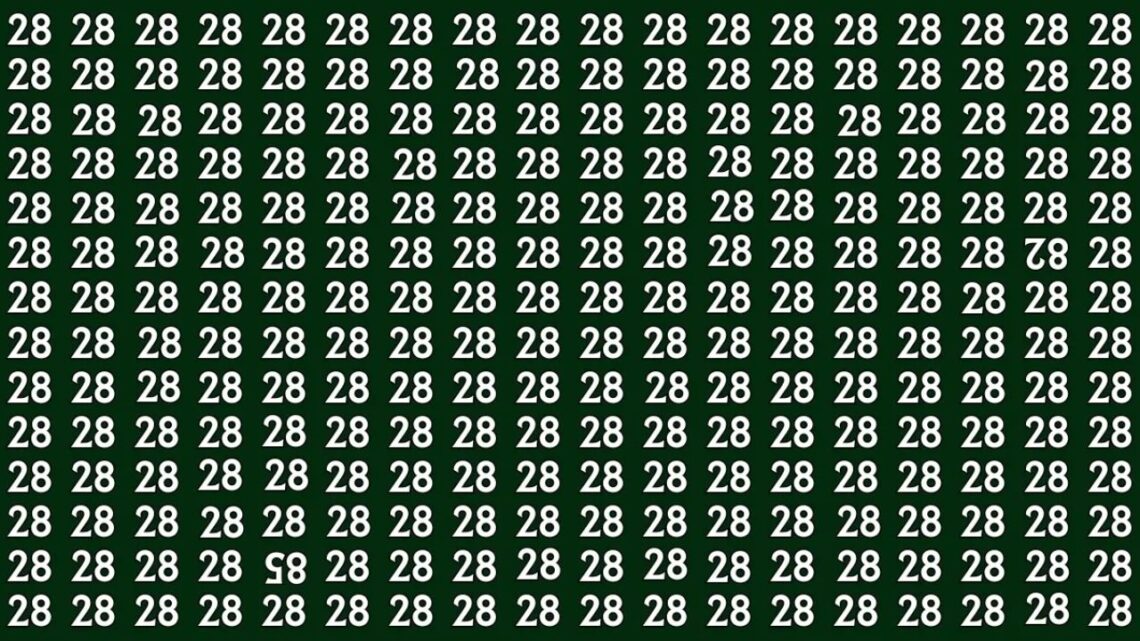Are you ready to test your observation skills with a mind-bending optical illusion challenge? At first glance, this puzzle looks simple—a grid packed entirely with the number “28.”
But hidden within the sea of repeating digits are two sneaky imposters: an inverted “82” and an inverted “85.”
The catch? You only have 6 seconds to find them. The numbers blend so seamlessly into the grid that most people miss them on the first try.
This brain-teasing puzzle not only entertains but also pushes your visual perception, attention to detail, and pattern recognition to the next level.
Think you’ve got the eagle eyes to spot both inverted numbers before the clock runs out? Let’s dive in and see if you can beat the challenge!
The Puzzle Setup
- The grid (for example, 8×8 or 10×10) is filled almost entirely with “28” repeated across rows and columns.
- Among them, exactly two entries are not “28” in the normal orientation: one is inverted “82”, the other is inverted “85”.
- You have only 6 seconds to scan and spot both inverted numbers before time runs out.
- At first glance, the grid appears uniform—that’s the illusion.
Key Locations & Clues
| Inverted Number | Row / Approximate Position | Visual Clue / What Looks Different |
|---|---|---|
| 82 (inverted) | Sixth row, ~ second column from right | It appears as a mirrored “28” — the “8” and “2” are flipped relative to neighbors |
| 85 (inverted) | Second row from bottom, near middle | Looks like a flipped “58” — the “5” is inverted, making it stand out among “28”s |
This table condenses the exact positions and visual hints—key to spotting them under time pressure.
How to Spot the Inverted “82”
- Focus your eyes on the sixth row (if the grid is 8+ rows).
- Look toward the right half, near the second column from the right.
- Compare digits: while most “28”s are upright and uniform, the inverted “82” will have the “8” and “2” reversed in orientation, making the silhouette subtly different.
- Because your brain expects “28”, it may overlook that one mirrored shape unless you scan deliberately.
How to Spot the Inverted “85”
- Shift your gaze to the second row from the bottom.
- Center your attention near the middle columns.
- Among the regular “28”s, the inverted “85” appears more like a “58”—its “5” is flipped, giving it a slightly odd contour.
- That subtle difference helps it pop out once you know what to look for.
Why This Illusion Works
- Pattern expectation: Your brain expects repetition (“28” everywhere) and tends to filter anomalies out.
- Visual blending: The inverted numbers are rotated in such a way that they mimic the shape of “28”, making detection harder.
- Time pressure: Six seconds is short, pushing your brain to rely on pattern shortcuts instead of detailed inspection.
- Small deviations: The flips are subtle—just enough to hide in plain sight.
Step-by-Step Detection Strategy
- Don’t stare in one place too long. Sweep your eyes row by row, left to right.
- Use contrast detection. Your peripheral vision may pick up differences before you consciously see them.
- Pause briefly on anomalies. If one “28” looks odd or less crisp, freeze and inspect.
- Know what to look for: The inverted “82” will appear as a mirrored “28,” and the inverted “85” will resemble a flipped “58.”
- Practice makes faster. Over time, your brain will sharpen for these subtle inverted shapes.
Final Reveal / Answer
- The inverted “82” resides in the sixth row, second from the right, disguised as a mirrored “28” in the sea of “28”s.
- The inverted “85” hides in the second row from the bottom, near the middle, appearing like a flipped “58” among upright “28”s.
If you didn’t catch both within 6 seconds, don’t worry—that’s the fun of it. Repeat a few times, and your eyes will start catching the anomalies faster.
This optical illusion is a clever test of visual perception, pattern recognition, and reaction under time pressure. By embedding inverted “82” and “85” among identical “28”s, the puzzle challenges your mind to overcome its own assumptions about uniformity.
Use the table, focus strategies, and clues above, and next time you try it, you’ll likely beat the 6-second clock.
Whether you solved it instantly or needed a hint, this kind of brain teaser strengthens attention to detail—and that’s a win for your cognitive skills.
FAQs
Why only 6 seconds?
Because the short time forces your brain to rely on fast pattern scanning rather than deliberate, slow inspection—making the puzzle more challenging.
Can any font or size break the illusion?
Yes—if digits are too distorted, too stylized, or spaced irregularly, the inversion may become too obvious or too subtle. The trick relies on consistent font and spacing.
How to train myself to spot such illusions faster?
Practice similar puzzles daily. Focus on anomalies in repetitive patterns, train peripheral awareness, and gradually reduce time allowed for spotting differences.
